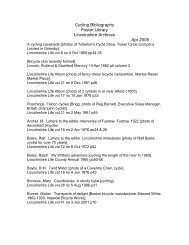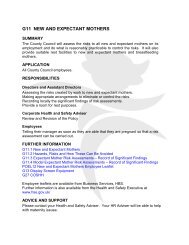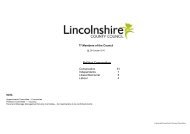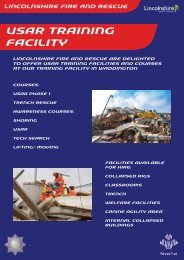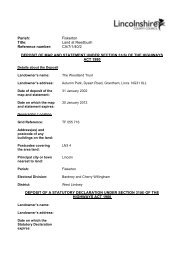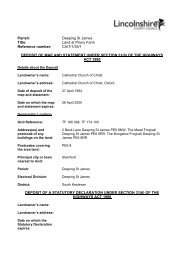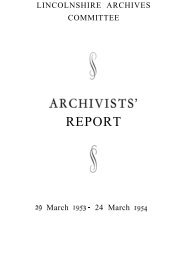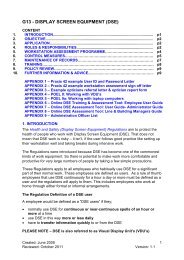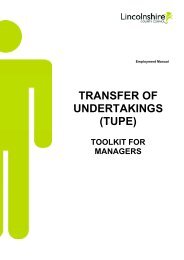Adobe PDF - Lincolnshire Archives Committee Archivists' Report 24 ...
Adobe PDF - Lincolnshire Archives Committee Archivists' Report 24 ...
Adobe PDF - Lincolnshire Archives Committee Archivists' Report 24 ...
You also want an ePaper? Increase the reach of your titles
YUMPU automatically turns print PDFs into web optimized ePapers that Google loves.
13<br />
an electric power plant on ground near the river, some distance from<br />
the works, only to find that when they wished to connect it to their<br />
works by cables under streets, they met with opposition from Sir<br />
Hickman Beckett Bacon who claimed to own the subsoil (2 B.D.<br />
1 G / 1 I - 15). In 1g 18 the vicar of Holy Trinity agreed to let the vicarage<br />
to Marshalls for a hostel for women working in the Company’s aircraft<br />
works, and to let part of Holy Trinity Institute for a place of<br />
recreation for the employees at the Carr House Aircraft Works (2 B.D.<br />
1G/ 17). For the eriod after the first World War, there are documents<br />
about the estab Pishment<br />
of the Gainsborough and District United<br />
Services Club, opened in 1921, which include its rules (2 B.D. 1G/22).<br />
Other bundles provide brief, unexpected glimpses into three unrelated<br />
aspects of life in Gainsborough: medical services, Roman<br />
Catholicism and a general election. In 1884 the firm acted for George<br />
Fyfe, M.D., who had recently bought a medical practice in the town,<br />
in a suit brought against him’ by another doctor, Theodore Cassan,<br />
who was Medical Officer to Marshalls’ Works Club, besides having<br />
a small private practice. George Howard’s malady, described in<br />
intimate detail by his wife and other women eye-witnesses, had not<br />
been relieved by Cassan, who had left him without medical attention<br />
until he could go into hospital. The distraught wife sought the aid<br />
of Dr. Fyfe, who gave the requisite treatment unaware that the patient<br />
was Cassan’s. The treatment, however, came too late and the patient<br />
died. Cassan’s claim that Fyfe had spoken slanderous words about his<br />
treatment of this case and his claim for damages failed. The records<br />
include extracts from Marshalls’ Club Minute Book about unsatisfactory<br />
treatment of other cases. Dr. Fyfe, it was revealed, gave advice<br />
gratis on Tuesdays (2 B.D. ‘F/30).<br />
The grandiose schemes and lack of financial sense of the Revd.<br />
Michael J. Gorman, Roman Catholic priest at Gainsborough, which<br />
brought the Catholics in the town into serious financial trouble, have<br />
served to afford a glimpse into their affairs in the 1880s. In 1881<br />
Gorman and the Revd. H. P. Cafferata, another priest, and the<br />
Sisters of the Convent of Mercy, who had been at Gainsborough since<br />
1877, contracted to buy the house belonging to W. H. Caldicott<br />
called the Old Rectory, but subsequently they decided merely to take<br />
a lease of it (2 B.D. 1C/2). An iron church was bought and erected<br />
in the rectory garden. For El505 a large site was urchased for schools<br />
to be run by the sisters, St. Joseph’s Collegiate Heminary,<br />
and L2,300<br />
‘was spent on the building. In 1880 the Duke of Norfolk had made<br />
a loan to the Convent, and in 1882 Mrs. Anna Maria Grainger, sister<br />
of the Roman Catholic Archbishop of Glasgow, lent ,E49000 on a<br />
mortgage of the land and schools. In 1886 Gorman, Cafferata and<br />
the former Mother Superior went bankru t and an assignment was<br />
made for the benefit of their creditors. TKe Duke was pressing for<br />
repayment of his loan and Mrs. Grainger was suing Gorman for her<br />
rincipal and interest. Though a well-wisher gave E1ooo to be used<br />
For<br />
the benefit of the creditors, Mrs. Grainger had no chance of<br />
recovering all her debt. In order, however, that she should recoup<br />
as much as possible, before she exercised her power of sale as mortgagee,<br />
in 1887, through the agency of Burton and Dyson, the land<br />
was developed and built on and new streets-Spital Terrace and<br />
Tennyson Street-were laid out. The iron church had been sold in<br />
1886, and the purchaser of the schools intended to demolish them.




